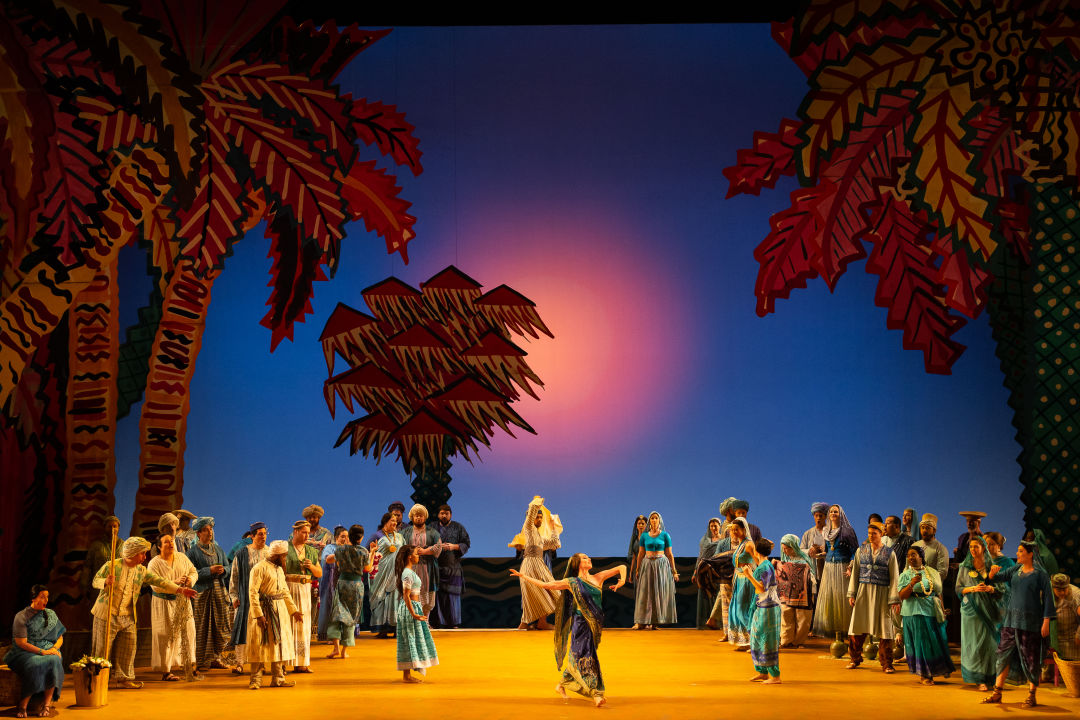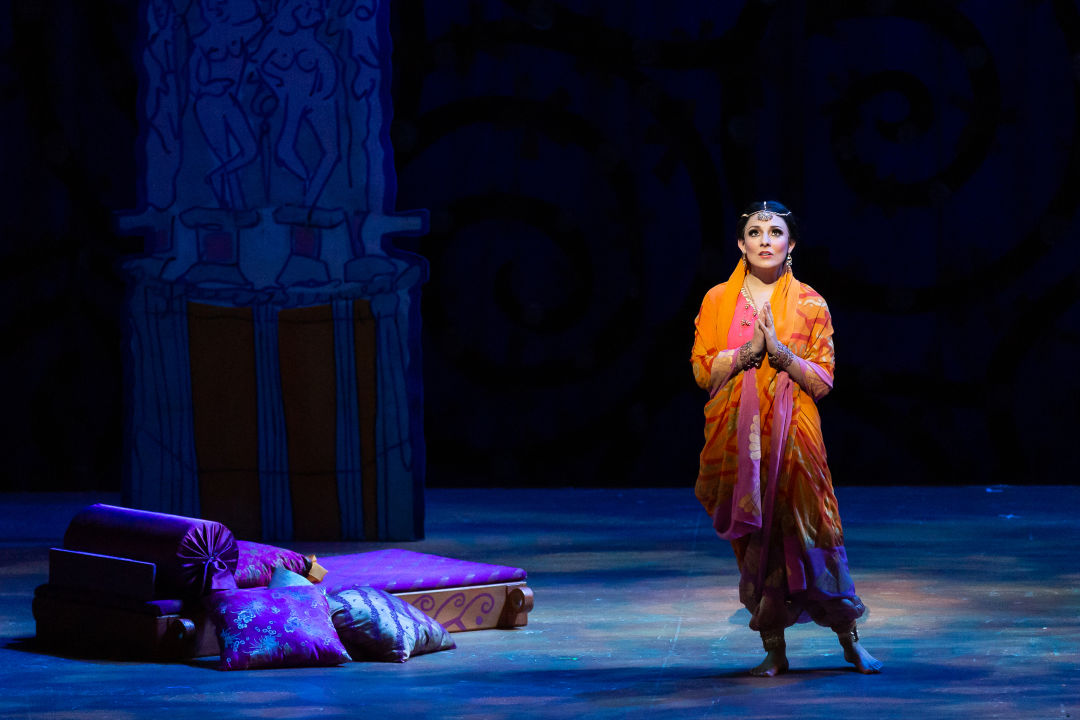Review: The Pearl Fishers Is A Transportive Musical Gem

Image: Lynn Lane
If Carmen is Bizet’s masterpiece, The Pearl Fishers is the lesser-known older sister: not quite as seductive, but equally persuasive in her own way. The Houston Grand Opera’s current production, directed by E. Loren Meeker, is a spectacle and a half, breathing new life into the work with imaginative visuals and a stellar cast.
With a weak, almost ridiculous storyline, a straightforward retelling with period staging would have spelled doom. Thankfully, British fashion designer Zandra Rhodes’ stylized take on the Sri Lankan setting is an over-the-top display of eye-popping color, featuring exotic Rousseau-like backdrops and figurines reminiscent of Matisse cutouts. Some of her sets were a bit cartoonish; I wasn’t a fan of the trees at the beginning (aptly described by one audience member as “Spongebob, under the sea”), but the later temple set, with its vividly etched pillars and backlit stars, felt wonderfully transportive.
The plot follows two men, friends since childhood: tribal leader Zurga and the hunter Nadir, who both fall in love with the beautiful priestess Leïla. In the opera’s most well-known tune at the beginning Act I, “Au fond du temple saint,” the two men vow to remain committed to their friendship instead, and from the way baritone Alexander Birch Elliott and tenor Lawrence Brownlee delivered that duet, we’re totally convinced.
Yet drama ensues when Leïla, played by soprano Andrea Carroll, shows up to the pearl-diving village in a colorful litter, this time as their protector priestess, vowed to chastity. Nadir, pining after Leïla all this time, discovers who she is. During their passionate duet in a forbidden tryst, the languid figurines on the temple pillars, in the first act alluring, appear ominous due to a shift in lighting (designed by Mark McCullough), and we all expect something to go very, very wrong. But still, the sudden arrival of the high priest Nourabad in a clap of thunder (played by Federico De Michelis) triggered quite a few gasps from the audience.
The ending is ultimately rather unbelievable, and the weak libretto is overall unfortunate—the writers of The Pearl Fishers famously said that if they’d known Bizet was such a good composer they would have written a better story—but the music remains luscious, with soaring duets and sumptuous choruses.

Andrea Carroll as Leïla in The Pearl Fishers.
Image: Lynn Lane
The vocal solos were breathtaking, with Carroll emerging as the star. She enters first as a tiny figure enrobed in a colorful sari and veil, and the moment she opens her mouth to sing her vows, we’re all transfixed. Surprisingly rich in the lower register with luminous clarity and purity in the top, her tone is perfectly suited for this role; Carroll handled Bizet’s slinky runs and trills with effortless agility. Leïla may be a rather two-dimensional character, but Carroll brought depth and nuance to the role. When she uttered, “Take your revenge, then, cruel man! Zurga, I curse you!” in her final solo, it felt empowering. We realize that she has both men in her grasp, and by now, the audience as well.
Brownlee, in his role as the love-sick Nadir, was earnest and convincing, and his silky, gorgeous timbre in the the pianissimo sections “Oh divine ecstasy!” was among the vocal highlights of the night. Nourabad sang with power and conviction as the oily high priest, and Birch Elliott, who stepped in last-minute to replace baritone Mariusz Kwiecien, struck an imposing and magnetic presence as Zurga. However, his vocal performance, though powerful, was not as emotionally nuanced, and his tonal intensity came off as too forceful in his soul-searching aria, “L'orage est calmé.”
Yet the most glorious music came from the pit and the chorus. I’ve never been more impressed with the orchestra—sonorous yet perfectly balanced, a testament to the deftness with which Roderick Cox led the ensemble. Bizet’s score is masterfully orchestrated, of course, but the responsiveness and sheer beauty the conductor drew from his musicians was a delight to witness. Further, The Pearl Fishers is as much about the villagers as the individual lovers, and their collective fury is viscerally enacted by the dancers, choreographed by Eric Sean Fogel, who cavort around almost crazed, excited for revenge. And the most powerful moments were delivered by the chorus, led by Richard Bado; the sudden shifts from the sublimely beautiful hymn “Brahma divin Brahma” to the shuddering menace of “Nadir will die at the rising of the sun” made the hair at the back of my neck rise.
Sure, the ending was a tad preposterous, but to the audience, it hardly mattered. This is the first time I’ve seen the Wortham give a standing ovation even to the chorus—people were springing from their chairs—and it was well deserved. Leïla may have lost her chance at the priceless pearl by forsaking her vow, but with the Houston Grand Opera’s production, we’ve got the gem in our hands.
Thru Feb. 8. Tickets from $25. Wortham Center, 510 Texas Ave. 713-228-6737. More info and tickets at houstongrandopera.org.




